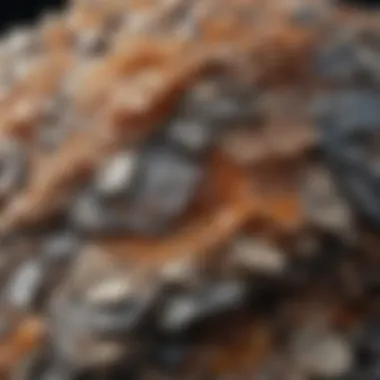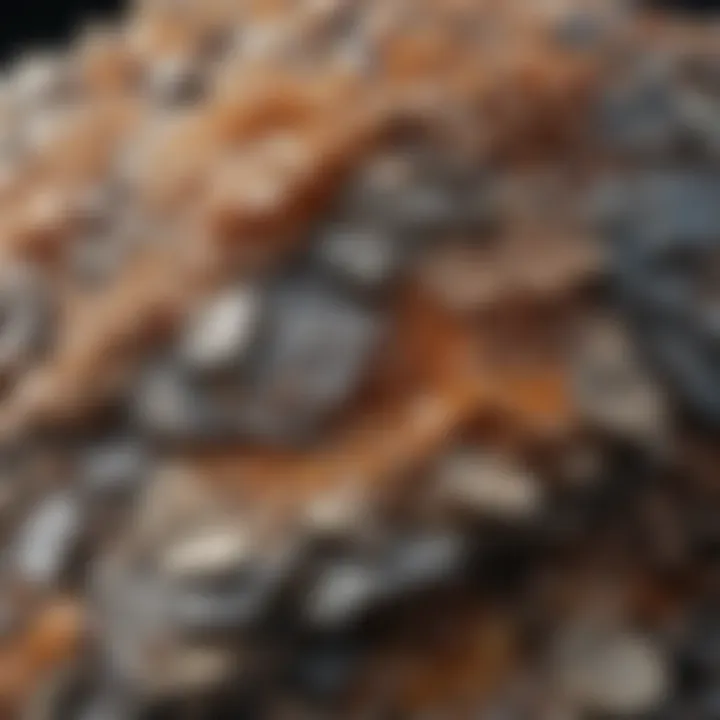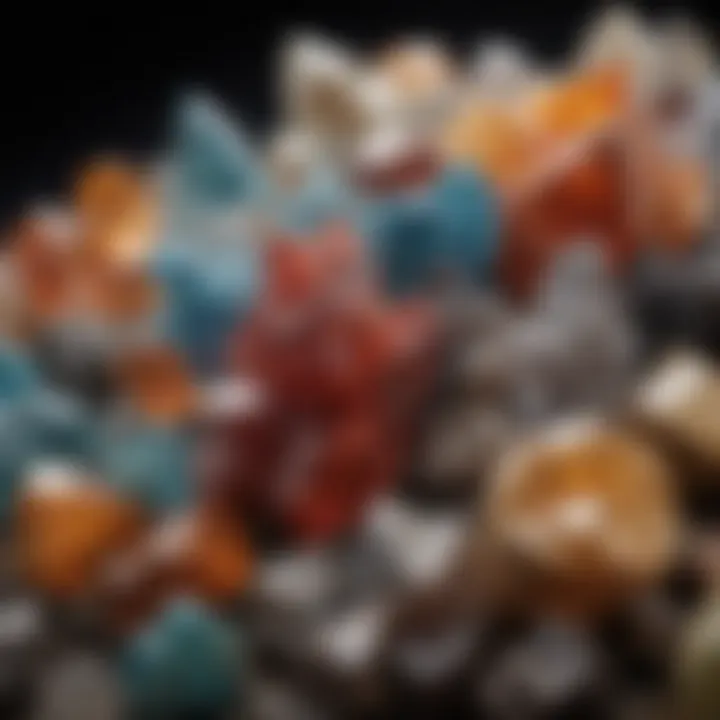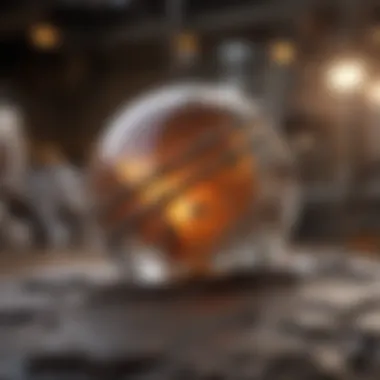Mica: Exploring Its Mineral Classification and Uses


Intro
Mica is often overshadowed by more glamorous minerals, but to overlook its significance would be a misstep. This mineral, known for its striking cleavage and variety of colors, plays a fundamental role in both natural and industrial contexts. Originally formed from intense heat and pressure in the Earth’s crust, mica stands as a bridge between geologic processes and everyday applications.
As we embark on this exploration, we’ll peel back the layers of mica—literally and metaphorically—unpacking its unique properties, classifications, and uses. By the end of this journey, you will not only understand what makes mica special but also appreciate its pervasive presence in various industries, ranging from electronics to cosmetics.
Featured Collectible of the Month
Overview
Each month, specific mineral specimens steal the spotlight in the collecting community, and right now, mica is taking its turn. Known for its perfect cleavage, which allows it to be separated into thin, flexible sheets, mica can be found in a multitude of colors such as green, brown, and even clear. Collectors are often drawn to distinct variations like muscovite, a light-colored mica, and biotite, the darker counterpart. These specimens can vary from shimmering flakes to large, lustrous sheets, making mica not just a mineral but a work of art in many cases.
Historical Significance
The history of mica dates back thousands of years, with its first known uses seen in ancient Rome and Egypt. Mica’s ability to withstand high temperatures and its electrical insulation properties lead to its early applications in ovens and as a decorative material in architecture. Today, its historical value is acknowledged not only for its utility but also for its aesthetic qualities. Many enthusiasts relish the opportunity to own specimens that carry a story, a narrative tied to centuries of human ingenuity.
"Mica is not just a mineral but a timeline, marking our journey from ancient uses to modern applications."
Identification Techniques
Visual Characteristics
Identifying mica is a delightful endeavor, primarily due to its unique features. Observers can look for the following:
- Cleavage: Mica is known for its perfect cleavage in one direction, which allows thin sheets to be easily peeled off.
- Luster: The mineral often exhibits a vitreous to pearly luster, catching light beautifully.
- Color: Mica can vary widely in hue; while the most common types exhibit shades of green and brown, it can also present in striking purple or even pink.
- Texture: Its sheets feel smooth and can be somewhat flexible, a tactile indicator that sets it apart from other minerals.
Resources for Identification
For those looking to deepen their understanding of mica and improve their identification skills, several resources are handy:
- The Mineralogy Database provides expansive information on different mica types.
- Mindat.org is an excellent platform for specific localities and collecting tips.
- Community forums on Reddit and Facebook offer real-time discussions where collectors can exchange advice and images of their finds.
Mica, with its multifaceted properties, offers treasure to collectors, geologists, and enthusiasts alike. By understanding what constitutes this remarkable mineral, one can better appreciate both its beauty and its industrial significance.
Definition of Mica
The definition of mica is a crucial starting point for anyone interested in this remarkable mineral. Mica is not just a shiny rock; it’s a group of silicate minerals known for their ability to split into thin sheets. This property makes mica unique, distinguishing it from many other minerals. One can't overlook the sheer range of applications it has influenced across various industries. From cosmetics to electronics, mica is everywhere, yet many still aren't entirely clear on what it really is. Understanding its definition helps illuminate its relevance in both geology and everyday life.
What Constitutes a Mineral?
To grasp mica better, we first need to define what constitutes a mineral. By strict geological definitions, a mineral is a naturally occurring, inorganic solid with a definite chemical composition and a crystalline structure. Mica ticks all these boxes:
- Naturally Occurring: Mica forms in nature under specific geological conditions. It’s not something humans create in a lab.
- Inorganic Solid: Unlike organic materials that come from living organisms, mica is purely inorganic. It's a solid, which means it has a definite shape and volume.
- Definite Chemical Composition: Mica consists of a specific arrangement of elements and compounds, the most common being potassium, aluminum, silicon, and oxygen.
- Crystalline Structure: The atoms in mica are arranged in an ordered, repeating pattern, which provides its layered structure.
When keeping this definition in mind, we see where mica stands as a mineral. Not only does it fulfill these criteria, but it also showcases exceptional properties that make it significant in various sectors.
Specific Properties of Mica
Mica is renowned for several specific properties that make it valuable across different fields. Here are a few key characteristics:
- Sheet-like Structure: This allows mica to be easily split into thin, flexible sheets. This distinct characteristic has numerous practical applications.
- Excellent Insulator: Mica is a poor conductor of electricity, which makes it ideal for electrical insulation in various electronic devices.
- Resistance to Heat: Its thermal stability allows it to withstand high temperatures, which is particularly useful in the manufacturing of insulators and in industrial applications.
- Transparency: Mica sheets can be transparent or translucent, which adds to their appeal, especially in decorative applications.
- Chemical Stability: Mica is not prone to many chemical reactions, allowing it to retain its properties even in harsh conditions.
Understanding these properties sheds light on the multitude of uses mica has found over the years, from enhancing beauty products to serving critical roles in industrial applications.
"Mica's versatility is a testament to nature’s ingenuity, finding purpose in everything from the elegance of makeup to the functionality of high-tech gadgets."
Chemical Composition of Mica
Mica, as a mineral, is not just a lightweight fancy name tossed into a discussion about geology; its chemical makeup is instrumental in defining its various forms and applications. Understanding the chemical composition of mica reveals the ingredients that skyrocket its desirability in industrial and collectible circles alike. The minerals that contribute to its synergistic blend provide insights into its properties and consequences, both geological and practical.
Elements that Form Mica


Mica primarily consists of silicates, particularly potassium, aluminum, silicon, and oxygen atoms. These elements come together in a unique arrangement that forms circular and flat layers, ideal for its characteristic cleavage. To break it down:
- Silicon (Si): A cornerstone of mica, silicon atoms connect with oxygen in a tetrahedral form, which creates the framework for the mineral.
- Oxygen (O): Essential in forming silicate structures, it bonds with other atoms, lending stability and shape to the crystalline form.
- Aluminum (Al): Plays a role in stabilizing the structure, often contributing to the various hues seen in mica crystals.
- Potassium (K): Gives rise to mica's layered structure. Potassium ions are the glue holding these layers together, allowing for the mineral's perfect cleavage.
With this elemental foundation, mica can further diverge into multiple varieties, each carrying distinct properties that make them appealing for specific uses.
Common Mica Varieties and Their Compositions
Diving deeper into mica's cosmos, one can venture into its different varieties, each with a unique chemical profile. Understanding these varieties isn't just academic—it can help collectors accurately identify and classify specimens they stumble upon.
- Muscovite: Often clear or slightly tinted, muscovite contains potassium and aluminum. Its composition allows for excellent translucency, making it frequent in the paper and paint industries.
- Phlogopite: Rich in magnesium, phlogopite boasts a darker hue. This variety is sought after for its thermal stability, making it valuable in electrical insulation applications.
- Biotite: This type has a higher iron content, giving it dark tones. Biotite's composition allows for increased density, which is essential for various geological studies and collecting.
"Mica is much more than skin-deep. Each variety tells a tale about the geological forces that have shaped it over millions of years."
The study in chemical composition does not just satiate intellectual curiosity; it also opens doors to practical applications and aesthetic appreciation. Whether one is studying this mineral in a lab, out in the field, or on display in a collection, grasping its chemical intricacies signifies a deeper respect for its role in both nature and industry.
Geological Formation of Mica
Mica, a mineral that captivates collectors and industry alike, derives its unique characteristics from the conditions that bring it into being. Understanding the geological formation of mica not only enhances one's appreciation of this mineral but also underscores its significance in various applications. Whether you're a novice exploring the world of geology or a seasoned collector, grasping how mica forms can deepen your engagement with this fascinating mineral.
Environmental Conditions for Mica Formation
Mica tends to emerge in specific geological settings. Most notably, it forms from the crystallization of magma and subsequent metamorphic processes. To put it simply, when magma cools and solidifies, minerals like mica can crystallize out of the molten rock. Additionally, mica is often associated with metamorphic rocks, like schist and gneiss, which form under heat and pressure.
Key conditions that favor mica formation include:
- High Temperatures and Pressures: These factors are critical for the metamorphosis of granitic rocks. Under such environments, elements combine to create layered silicates, which is the basis for mica.
- Presence of Water: Water can facilitate the movement of ions in metamorphic rock, aiding in the growth of mica crystals.
- Chemical Composition of Parent Rock: The original mineral content strongly influences the type of mica that develops. For example, rocks rich in aluminum and potassium can lead to the formation of muscovite, while magnesium-rich rocks may produce phlogopite.
The intricate dance of these elements and conditions results in the diverse varieties of mica that we recognize today. Without these unique environmental influences, we might not have had the wonders of this mineral at our fingertips.
Mining Processes of Mica
Once mica has formed, the next key step is its extraction from the earth. Mining processes vary depending on the type of mica and local geological conditions, but understanding the methods illuminates the challenges and impacts associated with mica production.
The two primary methods used to mine mica include:
- Open Pit Mining: This technique is commonly used in regions where mica deposits are near the surface. Workers remove topsoil and other materials to expose the mica layers beneath. It's efficient but can lead to significant environmental disruptions.
- Underground Mining: In areas where mica is found deeper within the earth, underground mining techniques are employed. This process involves creating tunnels and shafts to extract the mineral, presenting unique safety challenges but often with less surface impact.
"Mica mining can be a double-edged sword; it brings economic benefits but also raises ethical concerns around environmental degradation and worker conditions."
Often, mining operations may leave behind mineral waste and disturb the ecosystem, raising alarms among environmentalists and local communities. Ethical sourcing of mica has become a priority, as awareness grows about the repercussions of certain mining practices. Hence, vintage collectors and enthusiasts need to consider the history and practices behind the mica specimens they admire.
In summary, the geological formation and subsequent mining processes of mica illustrate the journey of this mineral from deep within the earth to a coveted place in collections and industries. Understanding these aspects not only enhances the experience of rock and mineral collectors but also highlights the importance of sustainable and ethical sourcing in the contemporary context.
Types of Mica
Understanding the various types of mica is critical, not just for collectors but for everyone interested in geology and mineralogy. Each type comes with its own unique properties, applications, and aesthetic qualities. This diversity not only enriches the world of minerals but also aids industries in technological and artistic realms.
Muscovite: The Common Mica
Muscovite is often referred to as the most familiar variety of mica. With its color ranging from clear to light brown, this mineral is prized for its impressive transparency and flexibility. What distinguishes muscovite is its perfect cleavage, which allows it to be peeled into thin sheets. These feature make it a staple in a like of applications.
Muscovite is widely used in electrical insulations, owing to its excellent dielectric strength. It serves a pivotal role in the aerospace industry as well as in the production of rubber and plastics. For rock collectors, its glossy sheen is appealing, and finding high-quality muscovite specimens can be quite thrilling. Some collectors even pursue rare forms that showcase strikingly unique crystal formations.
Phlogopite: A Lesser Known Variant
Phlogopite, while less commonly encountered, possesses its own set of interesting attributes. Typically dark brown or yellow in hue, this mica variant is notable for its heat resistance. Phlogopite is commonly used in fire-resistant products and serves as an effective insulating material in the automotive and aerospace industries. Notably, due to its unique color, it can often be confused with biotite by less experienced collectors.
For those who appreciate the nuances of mica, understanding phlogopite's composition and properties can enhance the appreciation for this rarer variety. It often presents a challenge in distinguishing it from its more common counterparts, thus making it all the more enticing for collectors.
Biotite: The Darker Mica
Biotite stands out due to its dark, often black appearance. This variety is rich in iron and magnesium, giving it a distinctive luster and color. Biotite is less utilized for commercial purposes than muscovite or phlogopite; however, it is still an important rock-forming mineral in igneous and metamorphic rocks.


For collectors, the presence of biotite in rock specimens can signal potential geological interest. Its shiny scales may catch light in interesting ways, making biotite a valuable addition to one's collection. It’s often found associated with feldspars and quartz, which provides collectors the opportunity to examine the interplay between different minerals.
"Each mica type serves a different purpose, reflecting the diversity of uses and forms found in nature."
In the landscape of mineral collecting, the type of mica chosen can significantly impact not only aesthetic value but also the educational aspect of the collection. By seeking out different varieties such as muscovite, phlogopite, and biotite, collectors can build a comprehensive understanding of what mica represents in both natural history and practical applications.
Mica in Industrial Applications
Mica, a mineral with unique properties, plays a crucial role in several industrial domains. Due to its physical and chemical characteristics, it’s become an irreplaceable resource in various applications. The demand for mica in modern industries showcases its versatility and significance.
Uses in Electronics and Insulation
One of the most notable applications of mica is in the electronics sector. Mica is a fantastic insulator, highly valued for its thermal stability and dielectric strength. Because it can withstand high temperatures without degrading, it’s often used to manufacture electrical insulators, capacitors, and other components. The sheets of mica can be cut into thin layers, making them ideal for insulating materials in devices such as transformers, motors, and generators.
Besides thermal resistance, mica helps in reducing electromagnetic interference, ensuring that electronic devices operate more reliably. This combination of properties makes mica essential when creating smaller and more efficient electronics, thereby pushing advancements in technology. The growing electronics industry relies heavily on sustainable mica sources, emphasizing the need for ethical practices in sourcing this valuable resource.
Role in Cosmetics and Personal Care
Mica finds its way into cosmetics, contributing to the aesthetic appeal of various products. Its shimmering appearance adds sparkle and shine, making it a common ingredient in makeup. Products like eyeshadows, blushes, and highlighters often contain mica to enhance their color and luminescence. The natural origins of mica allow many brands to market their products as more environmentally friendly options compared to synthetic alternatives.
Beyond aesthetics, mica also serves functional roles in personal care items. For instance, it can help create a smooth texture in creams and lotions, improving the application experience. Women and men alike value it, appreciating how mica-based products blend well on the skin, providing a natural, radiant look. The safety of using natural mica in cosmetics has led to a significant rise in its popularity, highlighting its ongoing relevance in the beauty industry.
Construction Uses of Mica
Mica’s properties extend beyond high-tech applications; it is equally valuable in the construction industry. Due to its resistance to heat and moisture, mica is often utilized in roofing, flooring, and as a component in cement and plaster. Its ability to form thin, flexible sheets allows contractors to incorporate it into various building materials. For instance, mica-based materials can provide excellent insulation, leading to energy-efficient buildings.
Furthermore, mica is employed in fire-resistant materials, making it an integral component of fireproofing and insulation. Thus, the mineral not only enhances the longevity of structures but also ensures greater safety for those who occupy these spaces. As the construction sector continues to innovate, the scope for mica applications is likely to expand, potentially leading to new formulations that fuse mica's benefits with emerging materials in sustainable building practices.
Mica's multifaceted roles across different industries underline its invaluable contribution to our modern world. From enhancing electronics, providing glamour in cosmetics, to ensuring safety in construction, mica is more than just a mineral; it's a cornerstone for innovation in various fields.
In summary, the industrial applications of mica are broad and varied, touching essential aspects of everyday life. Whether it's in the gadgets we use, the beauty products we apply, or the very structures we inhabit, mica’s significance cannot be understated. As the world shifts towards more sustainable practices, mica stands as a testament to how natural resources can serve modern demands while preserving their origins.
Mica as a Collector's Item
Mica has carved out a unique niche in the realm of collecting, attracting enthusiasts and experts alike. This mineral, with its distinct layered structure and remarkable shine, holds a certain allure that few can resist. The importance of collecting mica extends beyond mere aesthetics; it offers insights into geological processes, crystal formation, and the diverse ecological conditions in which these minerals originated.
When one engages with mica as a collector's item, it is not just about acquiring specimens, but also about understanding the story behind each crystal. Mica can embody the history of Earth, representing millions of years of natural evolution. For collectors, this aspect can be as fascinating as the collection itself.
Identifying Quality Mica Crystals
Identifying top-notch mica crystals requires some practice and a discerning eye. Here are the key factors to keep in mind:
- Clarity: Look for crystals that are transparent or have minimal inclusions. The fewer the imperfections, the more desirable the specimen.
- Luster: Quality mica should exhibit a bright, reflective surface. The sheen is often an indicator of the crystal’s quality.
- Layering: Mica’s characteristic thin layers can be stunning. Look for well-defined, smooth sheets that indicate excellent cleavage.
- Color Variations: While muscovite is predominantly colorless or light, phlogopite can show shades of brown or red. Unique hues can add value, particularly in rare varieties.
Understanding these identifiers can elevate a collector's game, turning what may seem like chance finds into intentional acquisitions worthy of display.
Caring for Mica Specimens
Once you’ve acquired quality mica specimens, taking care of them ensures they stay beautiful for years to come. Proper maintenance is vital for preservation. Consider the following care guidelines:
- Storage: Keep mica crystals in a cool, dry place. Avoid direct sunlight as UV rays can fade colors over time.
- Cleaning: If needed, gently wipe dust off using a soft, dry cloth. Avoid harsh chemicals and water, as mica is sensitive and might be damaged.
- Display: Use display cases that offer stability. Acrylic showcases protect crystals from dust and provide a clear view of your prized specimens.
By following these simple steps, collectors can ensure that their mica pieces do not just serve as minerals, but as lasting testaments to the beauty and complexity of nature.
"Every crystal tells a story, and mica, with its ethereal beauty and layered secrets, has much to reveal to those willing to look a little closer."
In the world of collecting, mica stands out not just for its visual appeal, but for the rich tapestry of historical and geological tales woven into each crystal. Understanding how to identify and care for these specimens can truly elevate the collecting experience.
Mica in Historical Context
The historical significance of mica stretches far beyond its simple crystalline beauty. This mineral, often likened to nature’s own glass, has woven its way into the fabric of various cultures across the globe. Understanding the historical context of mica offers insights not only into its practical applications but also into its cultural and artistic relevance throughout time.
Cultural Significance of Mica


From ancient civilizations to modern societies, mica has captured the imagination of many. In regions like India, the historical use of mica is quite notable. It is believed that artisans in ancient India incorporated mica into their craftsmanship, using it to enhance the aesthetic appeal of paintings and temple decorations. This reflects how mica wasn't merely a mineral; it was a symbol of beauty and spirituality.
In contrast, indigenous tribes in North America utilized mica in their rituals. Mica flakes were often embedded in masks and ceremonial items, reflecting the sun's light and creating an ethereal glow. For these communities, mica carried spiritual significance, linking them to their beliefs and practices. In fact, many tribes viewed it as a conduit between the earthly and spiritual realms.
"Mica was more than a mineral; it was a bridge to the divine for many cultures."
This cultural depth enriches the narrative around mica, positioning it not only as a resource but also as an entity entwined with identity and heritage across various groups.
Mica in Art and Artifacts
In the realm of art, mica has contributed to some spectacular pieces, especially in the realm of decorative arts. For artists, mica's reflective quality acts as a canvas of mesmerizing light, adding an element of depth and texture that few other materials can deliver. Traditional crafts in South Asia showcase intricate designs made with mica, drawing attention for their shimmering charm.
Moreover, mica's robust and flexible nature makes it ideal for applications in different types of artifacts. During the Renaissance, some artists used ground mica to create vibrant, iridescent pigments. This practice not only attests to mica's role in the artistic tradition but also highlights its versatility.
Noticeably, historical artifacts that utilized mica continue to be of interest to collectors and historians alike. They offer a glimpse into the technological understanding and craftsmanship of previous eras, showing how something as simple as a mineral can hold immense value in our understanding of cultural evolution.
Collectively, the examination of mica's usage in art and artifacts unveils a thread that connects various time periods and cultures. For collectors, whether a rock hound or a serious mineral enthusiast, recognizing the historical context adds layers of meaning to their specimens.
In summary, mica’s journey through time is marked by its diverse applications in both spiritual and artistic landscapes. This mineral, celebrated for its physical properties, simultaneously serves as a testament to human creativity and cultural expression.
Future Perspectives on Mica
The exploration of mica's future is significant, especially as industries evolve and adapt to sustainability concerns. In this current climate, where environmental impact is at the forefront of many discussions, understanding mica's role within ethical sourcing and innovative practices becomes crucial. Rock and fossil collectors, in particular, stand to benefit from being informed about these trends, as they may affect the availability and quality of mica specimens in the market.
Sustainability and Ethical Sourcing
Sustainability is not just a buzzword; it reflects a need for responsible practices in mineral extraction. Mica mining has garnered attention due to associated unethical labor practices, particularly in developing countries. It is vital to emphasize the importance of ethical sourcing as a means to ensure that mica is mined responsibly, without exploiting workers or harming the environment.
To promote sustainability in mica production:
- Adopt fair trade practices: Encouraging mines to pay fair wages to workers helps uplift communities.
- Support environmentally-friendly mining: Techniques that minimize land degradation can be crucial. This means utilizing methods that reduce waste and preserve local ecosystems.
- Engagement with local communities: Involving these communities in decision-making processes fosters trust and ensures that their needs are addressed.
Being mindful about choosing suppliers who adhere to ethical practices can positively influence the mica market, leading to increased demand for responsibly sourced materials. This aligns well with the values of collectors who value transparency in the origins of their specimens.
Innovations in Mica Usage
Innovation often shapes the future of materials used in various industries. Mica, despite its traditional applications, is witnessing new advancements that enhance its utility.
Research and development in materials science are uncovering exciting uses for mica:
- Nanotechnology: Mica flakes are being explored for their properties in nanocomposites, enhancing strength and durability in products.
- Green technologies: As the world gravitates towards sustainable energy, mica is being investigated for applications in solar panels due to its insulating properties.
- Cosmetic innovations: There’s a rising trend in the cosmetic industry to use mica as a natural pigment. This demands a closer look to ensure the mica sourced for these products is ethically mined.
"Mica’s properties make it a unique mineral that can adapt to emerging industries and sustainability goals."
As we consider the future, the continuous improvements in how mica is sourced, along with its innovative applications, might become significant talking points for collectors. These innovations could potentially increase the value and demand for certain types of mica, particularly those with verified ethical origins.
With changing consumer behaviors towards more sustainable choices, the practices surrounding mica could very well dictate the mineral's future in both retail and industrial settings. As collectors, being aware of these developments can pave the way for more informed decisions—leading to a deeper appreciation of mica as both a geological marvel and an economic player in modern markets.
Finale
In summing up the intricate story of mica, it becomes clear that this mineral is much more than just a pretty face in the world of geology. Mica embodies unique qualities that distinguish it from other minerals, making it significant in various applications. Not only does it display remarkable heat and electrical insulation properties, but its perfect cleavage makes it highly desirable for a variety of uses, from electronics to cosmetics. This article elucidates how understanding mica’s properties allows enthusiasts and professionals alike to appreciate its role in both nature and industry.
Recap of Mica’s Mineral Qualities
Mica’s reputation as a mineral lies in its distinct characteristics. First and foremost, its layered structure grants it flexibility and durability, making it resistant to heat and electricity. This very property enables its wide array of applications. Furthermore, its ability to reflect light results in the lustrous appearance that collectors find appealing in various species such as muscovite or biotite. Here’s a quick overview of mica’s essential mineral qualities:
- Layered Structure: Characteristic of its mineral family, permitting excellent cleavage.
- Electrical Insulation: An essential trait that makes it valuable in electrical and thermal insulation products.
- Chemical Resistance: Holds up well against numerous acids and other corrosive environments, prolonging its use in various industries.
In essence, mica's mineral qualities not only highlight its textbook properties but also serve as a cornerstone for its multifaceted applications.
The Importance of Mica in Modern Applications
Mica’s relevance today cannot be overstated. Its integration into contemporary industries speaks volumes about the mineral's adaptability and utility. For instance, in electronics, mica is indispensable as an insulator and dielectric material. Similarly, in cosmetics, mica provides the shimmer and glow that many products boast about. The construction sector, too, benefits from mica's inclusion in materials like paints and roofing tiles, adding durability and aesthetic value.
Here are several key industries where mica plays a crucial role:
- Electronics: Mica is extensively used in capacitors, diodes, and as a protective coating for wires.
- Aerospace and Automotive: High-performance parts often rely on mica for thermal protection.
- Cosmetics: Adds shine and texture to makeup products, making them more appealing.
- Construction: Enhances properties of construction materials, providing stability and resistance.
Mica continues to be a linchpin in various fields, proving itself not only as a mineral of beauty but also as an invaluable resource in technology and industry.



